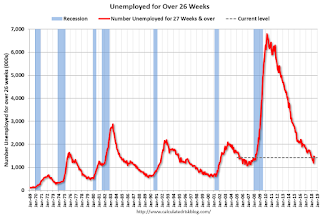by Calculated Risk on 8/03/2018 09:47:00 AM
Friday, August 03, 2018
Comments on July Employment Report
The headline jobs number at 157,000 for July was below consensus expectations of 190 thousand, however the previously two months were revised up by a combined 59 thousand. Overall this was a solid report.
Earlier: July Employment Report: 157,000 Jobs Added, 3.9% Unemployment Rate
In July, the year-over-year employment change was 2.400 million jobs. This is solid year-over-year growth.
Average Hourly Earnings
Wage growth was close to expectations in July. From the BLS:
"In July, average hourly earnings for all employees on private nonfarm payrolls rose by 7 cents to $27.05. Over the year, average hourly earnings have increased by 71 cents, or 2.7 percent."
 Click on graph for larger image.
Click on graph for larger image.This graph is based on “Average Hourly Earnings” from the Current Employment Statistics (CES) (aka "Establishment") monthly employment report. Note: There are also two quarterly sources for earnings data: 1) “Hourly Compensation,” from the BLS’s Productivity and Costs; and 2) the Employment Cost Index which includes wage/salary and benefit compensation.
The graph shows the nominal year-over-year change in "Average Hourly Earnings" for all private employees. Nominal wage growth was at 2.7% YoY in July.
Wage growth had been trending up, although growth has been moving more sideways recently.
Prime (25 to 54 Years Old) Participation
 Since the overall participation rate has declined due to cyclical (recession) and demographic (aging population, younger people staying in school) reasons, here is the employment-population ratio for the key working age group: 25 to 54 years old.
Since the overall participation rate has declined due to cyclical (recession) and demographic (aging population, younger people staying in school) reasons, here is the employment-population ratio for the key working age group: 25 to 54 years old.In the earlier period the participation rate for this group was trending up as women joined the labor force. Since the early '90s, the participation rate moved more sideways, with a downward drift starting around '00 - and with ups and downs related to the business cycle.
The 25 to 54 participation rate increased in July to 82.1%, and the 25 to 54 employment population ratio increased to 79.5%.
The participation rate had been trending down for this group since the late '90s, however, with more younger workers (and fewer 50+ age workers), the prime participation rate might move up some more. The employment population ratio is almost back to the pre-great recession highs.
Part Time for Economic Reasons
 From the BLS report:
From the BLS report:"The number of persons employed part time for economic reasons (sometimes referred to as involuntary part-time workers) was little changed in July, at 4.6 million, but was down by 669,000 over the year. These individuals, who would have preferred full-time employment, were working part time because their hours had been reduced or they were unable to find full-time jobs."The number of persons working part time for economic reasons has been generally trending down, and the number decreased in July to the lowest level since November 2007. The number working part time for economic reasons suggests three is still a little slack in the labor market.
These workers are included in the alternate measure of labor underutilization (U-6) that decreased to 7.5% in June. This is the lowest level for U-6 since May 2001.
Unemployed over 26 Weeks
 This graph shows the number of workers unemployed for 27 weeks or more.
This graph shows the number of workers unemployed for 27 weeks or more. According to the BLS, there are 1.435 million workers who have been unemployed for more than 26 weeks and still want a job. This was down from 1.478 million in June.
Summary:
The headline jobs number was below expectations, however the previous two months were revised up.
The headline unemployment rate decreased to 3.9%, and U-6 decreased to 7.5% - the lowest rate since 2001. Wages growth was close to expectations.
Overall, this was a solid report. For the first seven months of 2018, job growth has been solid averaging 215 thousand per month.


